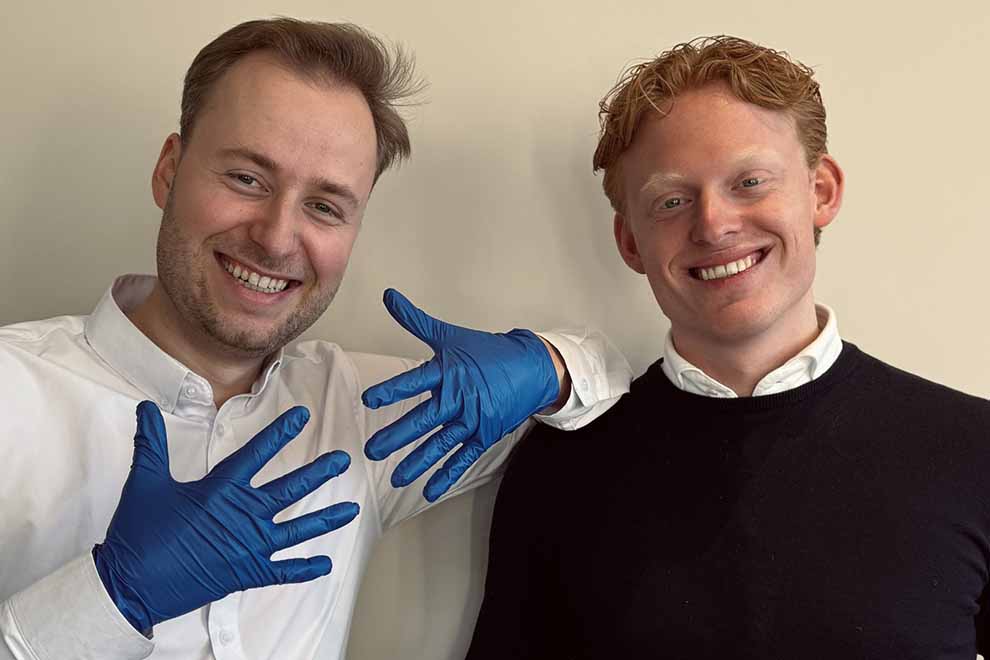Thijs Groenen and Matz van Noesel set out to find an eco-friendly alternative to bulk disposable gloves - and found nothing. So they developed the Gloovy Eco Gloves. And thus reached the finals of the National Care Innovation Award.
Matz van Noesel(pictured right) : "During the corona period, we saw a huge amount of disposable gloves being used, all of which were then burned. We thought we should be able to do that differently. So we started asking ourselves what raw materials could be used to make an alternative. We found that, together with Thijs' father who works in chemistry."
It became the Gloovy Eco Gloves. These can be used in the cleaning, medical and food sectors for all non-sterile handling. Groenen estimates that 90 percent of disposable gloves in healthcare facilities are replaceable.
The savings in emissions are enormous. Were you to dispose of the gloves in regular waste after use, the savings in CO2 emissions is already 50 percent, according to Van Noesel and Groenen. And if the gloves are recycled after use, the savings potential is 75 percent.
Bite-sized solution
The use, according to the inventors, is a "bite-sized solution with mega-impact. Van Noesel: "Disposable gloves are among the most polluting products in healthcare. If you tackle their use in your organization, you make very big steps without the need for large investments. You can start right away and you don't have to replace your entire fleet of vehicles first, for example. This is really much simpler."
Not the most expensive
According to Groenen, the gloves can compete perfectly well with existing ones on price. "We are not quite at the bottom with our price. That's because we also include the cost of collection and return. But we are reasonably competitive. There is a lot of difference in the prices of regular gloves. Ours are certainly not the most expensive."
Pricing is key. Groenen: "Sustainability is very important everywhere, until it costs too much. Then it quickly stops. That's where many initiatives run aground. From the very beginning, the question for us was what raw materials could we use to be able to offer a product that could still compete on price."
Challenge
The inventors started with prototypes about eight months ago. And in doing so, hooked into a challenge by cleaning company CSU Asito. Van Noesel: "We won it. This took us into a trial phase and gave us the opportunity to further improve the glove together with them. We came to a deal at the end of 2023, and they are going to use the gloves on a large scale."
The first party in healthcare has also joined in. Park Zuiderhout, a residential care complex in Teteringen, uses the gloves in care, cleaning and catering. The collection has also started there. The experience they gain there can be used again in other care organizations. Van Noesel and Groenen's aim is not to sell individual boxes, but to set up a system of delivery, collection and reuse in more and more care organizations.
Capacity
Capacity is currently 150,000 boxes per month. One box contains one hundred gloves. Groenen: "That is quite a lot, but not nearly enough. In the hospital sector, I think about 5 million boxes are used per year, so we still have to scale up considerably. A major advantage of our production process is that we can do that easily. Especially compared to regular gloves. Ours don't require complicated chemical processes."
Production takes place in Eastern Europe. This was a conscious decision, according to Van Noesel. "The collected gloves are processed in the Netherlands, but then they have to go back to the factory. If that is in Asia, our proposition no longer holds true. Then you lose a lot of the environmental gain in transport."
No external funding
Van Noesel and Groenen got their product to market relatively quickly. In doing so, they did not need external financing. "We worked seventy hours a week without a salary. Matz's father stepped in and that's how we've been able to get by so far. But as we now get more customers and have to pre-finance more inventory, there comes a time when we have to look for financing. For that we are also looking at grants, but those are long processes."
A thousand questions
A tip for other start-ups? Groenen: "Become a master of your own product. We don't have a chemical background; we hooked up other people for that. Know what you need help with. But then make sure you know exactly how everything is. They can ask Matz and me a thousand questions now, we have answers to everything."
What will they do with the prize money if they win? Van Noesel: "We're going to use that for product development. We're not done with that yet. There is a product now, but it can always be improved. The existing gloves have existed for fifty years; they have been fully developed. We still have plenty of work to do on ours.
Sustainable growth
Keeping focus will be the biggest challenge in the near future, Groenen said. "We could use our material for even more products. Or we could go across the border. We do, we have an appointment lined up with a very large cleaning company in Germany. But there is still a lot of work to do in the Netherlands. We already have a lot going on, but we need to grow sustainably."
Careinnovation.comwill award the National Healthcare Innovation Prize for the ninth time in 2024 for the most innovative healthcare innovation in the scale-up phase. Participants have a chance to win the professional jury prize worth 10,000 euros and the public prize worth 5,000 euros. The eight finalists will be announced in the coming weeks. They will pitch during theHealth Valley Eventon March 21 their healthcare innovation in front of an expert professional jury. Voting for the public award is open from March 20 to April 3. The winners will be announced on April 10 duringCare & ict, part of Dutch Health Week. The finalists will receive a spot on the Heart of Health square during this event.












